A Conceptual Framework to Design Green Infrastructure: Ecosystem Services as an Opportunity for Creating Shared Value in Ground Photovoltaic Systems
Abstract
1. Introduction
2. The GPV System Conceived as Green Infrastructure
- What are the landscape needs we want to address? It is important to identify and focus on the ecological, social and economic target needs of the reference context.
- What are the ecosystem services linked to these problems? It is necessary to focus on the type of ecosystem services, biophysical structures and ecological functions that can satisfy the human and business needs identified.
- What are the potential solutions? It is necessary to think about technical solutions when developing GI to support the priority ecosystem services.
- Why do we choose these solutions? It is useful to identify all ecosystem services, other than the priorities, that can be developed and the benefits they can produce for human wellbeing and the potential additional income for businesses.
3. Practical Application of the Framework to a Case Study
- Step 1. Identification of the social, ecological and economic needs between GPV systems and the context of reference, including the landscape issues analysis on the regional level about GPV systems, considering the present vegetation types and the relationship existing between “pore space” and full space in the same GPV systems.
- Step 2. Identification of the priority ecosystem services and the main biophysical structures and ecological functions that we want to develop in the design of the GPV systems as GI.
- Step 3. Indication of the pattern relationship and interaction between vegetation that is able to produce specific ecosystem services and panel technology (height above the ground, distance between the panels): characterisation of the activities carried out to reduce the risk of fire and shading of the panels due to uncontrolled vegetation growth.
- Step 4. Indication of the social–ecological and potential business benefits: characterisation of all the variations of ecosystem services that can be supported with the GI solutions and potential economic income.
3.1. Step 1. Multiscale Analysis
3.1.1. Characterisation of the Ecological and Social Issues in the Apulia Region
3.1.2. Characterisation of “Pore Spaces” and “Full Spaces” in GPV Systems
3.2. Step 2. Identification of the Priority Ecosystem Services and the Project Idea
- SFS-h (subsurface flow system—horizontal);
- SFS-v (subsurface flow system—vertical);
- FWS (free water surface).
3.3. Step 3. Design of Innovation Green Technological Solutions
- Solution 1: Type 1 (SFS: space around the GPV panels) + Type 2 (FWS: pore space and space under the GPV panels);
- Solution 2: Type 1 (SFS: space around and between the GPV panels) + Type 2 (FWS: space around, between and under the GPV panels).
3.4. Step 4. Framework of the Project as Green Infrastructure: Ecological, Social and Economic Potential Externalities
3.4.1. Quantification of the Potential Air Temperature Regulation of the CTW Elements
3.4.2. A New Vision of GPV Systems as Green Infrastructure
4. Discussion
5. Conclusions
- The realisation of GPV systems as GI does not represent a simple mitigation measure, but a development strategy that administrators (local, regional and national) can employ to create added ecological and socioeconomic values in the urban context.
- Ecosystem functions are reinterpreted as supporting technology services to produce innovative thinking as the capacity to do the same things in different ways.
Author Contributions
Funding
Conflicts of Interest
References
- Foley, J.A.; DeFries, R.; Asner, G.P.; Barford, C.; Bonan, G.; Carpenter, S.R.; Sha, S. Global consequences of land use. Science 2005, 309, 570–574. [Google Scholar] [CrossRef] [PubMed]
- CE. Sustainable Urban Development. 2018. Available online: http://ec.europa.eu/regional_policy/it/policy/themes/urban-development/ (accessed on 23 April 2020).
- Gallo, K.P.; Easterling, D.R.; Peterson, T.C. The influence of land use/land cover on climatological values of the diurnal temperature range. J. Clim. 1996, 9, 2941–2944. [Google Scholar] [CrossRef]
- Lal, R. Soil carbon sequestration impacts on global climate change and food security. Science 2004, 304, 1623–1627. [Google Scholar] [CrossRef]
- Pielke, R.A.; Marland, G.; Betts, R.A.; Chase, T.N.; Eastaman, J.L.; Niles, J.O.; Niyogi, D.; Running, S.W. The influence of land-use change and landscape dynamics on the climate system: Relevance to climate-change policy beyond the radiative effect of greenhouse gases. Philos. Trans. R. Soc. A Math. Phys. Eng. Sci. 2002, 360, 1705–1719. [Google Scholar] [CrossRef]
- Kalnay, M.E.; Cai, M. Impact of urbanization and land-use change on climate. Nature 2003, 423, 528–531. [Google Scholar] [CrossRef]
- Maggiore, G.; Semeraro, T.; Aretano, R.; De Bellis, L.; Luvisi, A. GIS analysis of land-use change in threatened landscapes by Xylella fastidiosa. Sustainability 2019, 11, 253. [Google Scholar] [CrossRef]
- Matson, P.A.; Parton, W.J.; Power, A.G.; Swift, M.J. Agricultural intensification and ecosystem properties. Science 1997, 277, 504–509. [Google Scholar] [CrossRef]
- Bennett, E.M.; Carpenter, S.R.; Caraco, N.F. Human impact on erodible phosphorous and eutrophication: A global perspective. BioScience 2011, 51, 227–234. [Google Scholar] [CrossRef]
- Costanza, R.; d’Arge, R.; De Groot, R.; Farber, S.; Grasso, M.; Hannon, B.; Limburg, K.; Naeem, S.; O’neill, R.V.; Paruelo, J.; et al. The value of the world’s ecosystem service and natural capital. Nature 1997, 387, 253–260. [Google Scholar] [CrossRef]
- MEA (Millennium Ecosystem Assessment). Ecosystems and Human Well-Being: Synthesis; Island Press: Washington, DC, USA, 2005. [Google Scholar]
- De Groot, R.; Brander, L.; Van der Ploeg, S.; Costanza, R.; Bernard, F.; Braat, L.; Christie, M.; Crossman, N.; Ghermandi, A.; Hein, L.; et al. Global estimates of the value of ecosystems and their services in monetary units. Ecosyst. Serv. 2012, 1, 50–61. [Google Scholar] [CrossRef]
- Semeraro, T.; Pomes, A.; Aretano, R. Green roof technology as a sustainable strategy to improve water urban availability. IOP Conf. Ser. Mater. Sci. Eng. 2019, 471, 092065. [Google Scholar] [CrossRef]
- Chiabrando, R.; Fabrizio, E.; Garnero, G. The territorial and landscape impacts of photovoltaic systems: Definition of impacts and assessment of the glare risk. Renew. Sustain. Energy Rev. 2009, 13, 2441–2451. [Google Scholar] [CrossRef]
- Fthenakis, V.; Kim, H.C. Land use and electricity generation: A life-cycle analysis. Renew. Sustain. Energy Rev. 2009, 13, 1465–1474. [Google Scholar] [CrossRef]
- Lovich, J.E.; Ennen, J.R. Wildlife conservation and solar energy development in the Desert Southwest, United States. Bioscience 2011, 61, 982–992. [Google Scholar] [CrossRef]
- Dias, L.; Gouveria, J.P.; Lourenco, P.; Seixas, J. Interplay between the potential of photovoltaic systems and agricultural land use. Land Use Policy 2019, 81, 725–735. [Google Scholar] [CrossRef]
- Hernandez, R.R.; Easter, S.B.; Murphy-Mariscal, M.L.; Maestre, F.T.; Tavassoli, M.; Allen, E.B.; Barrows, C.W.; Belnap, J.; Ochoa-Hueso, R.; Ravi, S.; et al. Environmental impacts of utility-scale solar energy. Renew. Sustain. Energy Rev. 2014, 29, 766–779. [Google Scholar] [CrossRef]
- Lakhani, R.; Doluweera, G.; Bergerson, J. Internalizing land use impacts for life cycle cost analysis of energy systems: A case of California’s photovoltaic implementation. Appl. Energy 2014, 116, 253–259. [Google Scholar] [CrossRef]
- Semeraro, T.; Pomes, A.; Del Giudice, C.; Negro, D.; Aretano, R. Planning ground based utility scale solar energy as green infrastructure to enhance ecosystem services. Energy Policy 2018, 117, 218–227. [Google Scholar] [CrossRef]
- Semeraro, T.; Aretano, R.; Pomes, A. Green infrastructure to improve ecosystem services in the landscape urban regeneration. IOP Conf. Ser. Mater. Sci. Eng. 2017, 245, 082044. [Google Scholar] [CrossRef]
- Scognamiglio, A.; Garde, F.; Monnier, A.; Scotto, E. Photovoltaic greenhouses: A feasible solutions for islands? Design, operation, monitoring and lessons learned from a real case study. In Proceedings of the 6th World Conference on Photovoltaic Energy Conversion, Kyoto, Japan, 23–27 November 2014; Volume 12, pp. 1169–1070. [Google Scholar]
- Stremke, S.; Van den Dobbelsteen, A. (Eds.) Sustainable energy landscapes: An introduction. In Sustainable Energy Landscapes: Designing, Planning, Development; CRC Press: New York, NY, USA, 2013. [Google Scholar]
- Lawler, J.J.; Lewis, D.J.; Nelson, E.; Plantinga, A.J.; Polasky, S.; Withey, J.C.; Helmrs, D.P.; Martinuzzi, S.; Pennington, D.; Radeloff, V. Projected land-use change impacts on ecosystem services in the United States. Proc. Natl. Acad. Sci. USA 2014, 20, 7492–7497. [Google Scholar] [CrossRef]
- De groot, R.S.; Alkemade, R.; Braat, L.; Hein, L.; Willemen, L. Challenges in integrating the concept of ecosystem services and values in landscape planning, management and decision making. Ecol. Complex. 2010, 7, 260–272. [Google Scholar]
- The Economics of Ecosystems & Biodiversity. TEEB Manual for Cities: Ecosystem Services in Urban Management; TEEB, 2011; Available online: http://www.teebweb.org/wp-content/uploads/Study%20and%20Reports/Additional%20Reports/Manual%20for%20Cities/TEEB%20Manual%20for%20Cities_English.pdf (accessed on 10 May 2020).
- Bryan, B.A.; Crossman, N.D. Impact of multiple interacting financial incentives on land use change and the supply of ecosystem services. Ecosyst. Serv. 2013, 4, 60–72. [Google Scholar] [CrossRef]
- Carpenter, S.R.; Mooney, H.A.; Agard, J.; Capistrano, D.; DeFries, R.S.; Díaz, S.; Dietz, T.; Duraiappah, A.K.; Oteng-Yeboah, A.; Pereira, H.M.; et al. Science for managing ecosystem services: Beyond the millennium ecosystem assessment. Proc. Natl. Acad. Sci. USA 2009, 106, 1305–1312. [Google Scholar] [CrossRef] [PubMed]
- TEEB (The Economics of Ecosystems and Biodiversity). Ecological and Economic Foundations; Kumar, P., Ed.; Earthscan: London, UK; Washington, DC, USA, 2010. [Google Scholar]
- Liu, J.; Mooney, H.; Hull, V.; Davis, S.J.; Gaskell, J.; Hertel, T.; Lubchenco, J.; Seto, K.C.; Seto, P.H.; Kremen, C.; et al. Systems integration for global sustainability. Science 2015, 347, 1258832. [Google Scholar] [CrossRef]
- European Commission (EC). Green Infrastructure (GI)—Enhancing Europe’s Natural Capital; Communication from the Commission to the European Parliament, the Council, the European Economic and Social Committee and the Committee of the Regions; European Commission: Brussels, Belgium, 2013. [Google Scholar]
- Ahern, J. From fail-safe to safe-to-fail: Sustainability and resilience in the new urban world. Landsc. Urban Plan. 2011, 100, 341–343. [Google Scholar] [CrossRef]
- Pulighe, G.; Fava, F.; Lupia, F. Insights and opportunities from mapping ecosystem services of urban green spaces and potentials in planning. Ecosyst. Serv. 2016, 22, 1–10. [Google Scholar] [CrossRef]
- Schrijnen, P.M. Infrastructure networks and red-green patterns in city regions. Landsc. Urban Plan. 2000, 48, 191–204. [Google Scholar] [CrossRef]
- Semeraro, T.; Zaccarelli, N.; Lara, A.; Cucinelli, F.; Aretano, R. A bottom-up and top-down participatory approach to planning and designing local urban development: Evidence from an urban university center. Land 2020, 9, 98. [Google Scholar] [CrossRef]
- Tzoulas, K.; Korpela, K.; Venn, S.; Yli-Pelkonen, V.; Kazmierczak, A.; Niemelä, J.; James, P. Promoting ecosystem and human health in urban areas using Green Infrastructure. A literature review. Landsc. Urban Plan. 2007, 81, 167–178. [Google Scholar] [CrossRef]
- Lafortezza, R.; Davies, C.; Sanesi, G.; Konijnendijk, C. Green Infrastructure as a tool to support spatial planning in European urban regions. Forest 2013, 6, 102–108. [Google Scholar] [CrossRef]
- Lovell, S.T.; Taylor, J.R. Supplying urban ecosystem services through multifunctional green infrastructure in the United States. Landsc. Ecol. 2013, 28, 1447–1463. [Google Scholar] [CrossRef]
- Lambin, E.F.; Meyfroidt, P. Land use transitions: Socio-ecological feedback versus socio-economic change. Land Use Policy 2010, 27, 108–118. [Google Scholar] [CrossRef]
- European Commission. EU Biodiversity Strategy for 2030; Communication from the Commission to the European Parliament, the Council, the European Economic and Social Committee and the Committee of the Regions; European Commission: Brussels, Belgium, 2020. [Google Scholar]
- Scognamiglio, A. Photovoltaic landscapes’: Design and assessment. A critical review for a new transdisciplinary design vision. Renew. Sustain. Energy Rev. 2016, 55, 629–661. [Google Scholar] [CrossRef]
- Kapetanakis, I.A.; Kolokotsa, D.; Maria, E.A. Parametric analysis and assessment of the photovoltaics’ landscape integration: Technical and legal aspects. Renew. Energy 2014, 67, 207–214. [Google Scholar] [CrossRef]
- Denholm, P.; Margolis, R.M. Land use requirements and the per-capita solar footprint for photovoltaic generation in the United States. Energy Policy 2008, 36, 3531–3543. [Google Scholar] [CrossRef]
- Montag, H.; Parker, G.; Clarkson, T. The Effects of Solar Farms on Local Biodiversity; A Comparative Study. Clarkson and Woods and Wychwood Biodiversity. 2016. Available online: https://www.solar-trade.org.uk/wp-content/uploads/2016/04/The-effects-of-solar-farms-on-local-biodiversity-study.pdf (accessed on 11 May 2020).
- Ketzer, D.; Weinberger, N.; Rösch, C.; Seitz, S.B. Land use conflicts between biomass and power production – citizens’ participation in the technology development of Agrophotovoltaics. J. Responsible Innov. 2019, 24, 2329–9460. [Google Scholar] [CrossRef]
- Schindele, S.; Maximilian, T.; Schlaak, A.; Obergfell, T.; Bopp, G.; Reise, C.; Braun, C.; Weselek, A.; Bauerle, A.; Högy, P.; et al. Implementation of agrophotovoltaics: Techno-economic analysis of the price-performance ratio and its policy implications. Appl. Energy 2020, 265, 114737. [Google Scholar] [CrossRef]
- Weselek, A.; Ehmann, A.; Zikeli, S.; Lewandowski, I.; Schindele, S.; Högy, P. Agrophotovoltaic systems: Applications, challenges, and opportunities. A review. Agron. Sustain. 2019, 39, 35. [Google Scholar] [CrossRef]
- Goetzberger, A.; Zastrow, A. On the coexistence of solar-energy conversion and plant cultivation. Int. J. Sol. Energy 1982, 1, 55–69. [Google Scholar] [CrossRef]
- Campbell, B.M.; Vermeulen, S.; Aggarwal, P.K.; Cormer Doloff, C.; Girvetz, E.; Loboguerrero, A.M.; Villegas, J.R.; Rosenstock, T.; Sebastian, L.; Thornton, P.K.; et al. Reducing risks to food security from climate change. Glob. Food Secur. 2016, 11, 34–43. [Google Scholar] [CrossRef]
- Fritsche, U.R.; Berndes, G.; Cowie, A.L.; Dale, V.H.; Kline, K.L.; Johnson, F.X.; Langeveld, H.; Sharma, N.; Watson, H.; Woods, J. Global Land Outlook Working Paper Energy and Land Use; UNCCD, IRENA, 2017; Available online: https://knowledge.unccd.int/sites/default/files/2018-06/2.%20Fritsche%2Bet%2Bal%2B%282017%29%2BEnergy%2Band%2BLand%2BUse%2B-%2BGLO%2Bpaper-corr.pdf (accessed on 25 April 2020).
- Xue, J. Photovoltaic agriculture—New opportunity for photovoltaic applications in China. Renew. Sustain. Energy Rev. 2017, 73, 1–9. [Google Scholar] [CrossRef]
- Potts, S.G.; Imperatriz-Fonseca, V.; Ngo, H.T.; Aizen, M.A.; Biesmeijer, J.C.; Breeze, T.D.; Dicks, L.V.; Garibaldi, L.A.; Hill, R.; Settele, J.; et al. Safeguarding pollinators and their values to human well-being. Nature 2016, 540, 220–229. [Google Scholar] [CrossRef] [PubMed]
- Potts, S.G.; Biesmeijer, J.C.; Kremen, C.; Neumann, P.; Schweiger, O.; Kunin, W.E. Global pollinator declines: Trends, impacts and drivers. Trends Ecol. Evol. 2020, 25, 345–353. [Google Scholar] [CrossRef]
- European Commission, European Commission-Environment-Nature and biodiversity-EU Pollinators. #EUPollinators: Small, precious and in need of protection! 2020. Available online: https://ec.europa.eu/environment/nature/conservation/species/pollinators/index_en.htm (accessed on 1 June 2020).
- Vanbergen, A.J. The insect pollinators initiative, threats to an ecosystem service: Pressures on pollinators. Front. Ecol. Environ. 2013, 11, 251–259. [Google Scholar] [CrossRef]
- Turney, D.; Fthenakis, V. Environmental impacts from the installation and operation of large-scale solar power plants. Renew. Sustain. Energy Rev. 2011, 15, 3261–3270. [Google Scholar] [CrossRef]
- Skoplaki, E.; Palyvos, J.A. Operating temperature of photovoltaic modules: A survey of pertinent correlations. Renew. Energy 2009, 34, 23–29. [Google Scholar] [CrossRef]
- Kaiser, A.S.; Zamora, B.; Mazón, R.; García, J.R.; Vera, F. Experimental study of cooling BIPV modules by forced convection in the air channel. Appl. Energy 2014, 135, 88–97. [Google Scholar] [CrossRef]
- Chemisana, D.; Lamnatou, C. Photovoltaic-green roofs: An experimental evaluation of system performance. Appl. Energy 2014, 119, 246–256. [Google Scholar] [CrossRef]
- Shafique, M.; Kim, R.; Rafiq, M. Green roof benefits, opportunities and challenges–A review. Renew. Sustain. Energy Rev. 2018, 90, 757–773. [Google Scholar] [CrossRef]
- Porter, M.E.; Kramer, M.R. Creating shared value: How to reinvent capitalism and unleash a wave of innovation and growth. Harv. Bus. Rev. 2011, 89, 62–77. [Google Scholar]
- Institute for Strategy & Competitiveness. Creating Shared Value. 2020. Available online: https://www.isc.hbs.edu/creating-shared-value/Pages/default.aspx (accessed on 1 March 2020).
- Sahu, A.; Yadav, N.; Sudhakar, K. Floating photovoltaic power plant: A review. Renew. Sustain. Energy Rev. 2016, 66, 815–824. [Google Scholar] [CrossRef]
- Saura, S.; Bodin, Ö.; Fortin, M.J.; Frair, J. Stepping stones are crucial for species’ long-distance dispersal and range expansion through habitat networks. J. Appl. Ecol. 2013. [Google Scholar] [CrossRef]
- Landsberg, F.; Treweek, J.; Stickler, M.M.; Henninger, N.; Venn, O. Weaving Ecosystem Services into Impact Assessment; World Resources Institute: Washington, DC, USA, 2013. [Google Scholar]
- Luo, T.; Young, R.; Reig, P. Aqueduct projected water stress rankings. In Technical Note; World Resources Institute: Washington, DC, USA, 2015; Available online: http://www.wri.org/publication/aqueduct-projected-water-stress-country-rankings (accessed on 5 March 2020).
- Photovoltaic Geographical Information System. Available online: http://rejrc.ec.europa.eu/pvgtools/en/tools.html (accessed on 5 March 2020).
- Sirisamphanwong, C.; Ketjoy, N. Impact of spectral irradiance distribution on the outdoor performance of photovoltaic system under Thai climatic conditions. Renew. Energy 2012, 38, 69–74. [Google Scholar] [CrossRef]
- Belessiotis, V.; Kalogirou, S.; Delyannis, E. Chapter six–Indirect solar desalination (MSF, MED, MVC, TVC). In Thermal Solar Desalination Methods and Systems; Academic Press, Elsevier, 2016; pp. 283–326. Available online: https://books.google.it/books?id=kSbjCwAAQBAJ&pg=PA283&lpg=PA283&dq=Chapter+six%E2%80%93Indirect+solar+desalination+(MSF,+MED,+MVC,+TVC).+In+Thermal+Solar+Desalination+Methods+and+Systems&source=bl&ots=XpJ32fhL5g&sig=ACfU3U2CJl_Sd3SwYK7T_SOAAr9bH02pnw&hl=it&sa=X&ved=2ahUKEwi66rPd_93qAhVK3qQKHURTDE0Q6AEwAnoECAoQAQ#v=onepage&q=Chapter%20six%E2%80%93Indirect%20solar%20desalination%20(MSF%2C%20MED%2C%20MVC%2C%20TVC).%20In%20Thermal%20Solar%20Desalination%20Methods%20and%20Systems&f=false (accessed on 10 April 2020).
- Li, T.; Dong, Y.; Liu, Z. A review of social-ecological system resilience: Mechanism, assessment and management. Sci. Total Environ. 2020, 723, 138113. [Google Scholar] [CrossRef] [PubMed]
- GSE Gestore Servizi Elettrici. ATLASOLE: Atlante degli Impianti Fotovoltaici (Electrical Services Manager. ATLASOLE: Atlas of Photovoltaic Plants). 2017. Available online: https://www.gse.it/dati-e-scenari/atlaimpianti (accessed on 1 June 2019).
- RTA (Regional Tourism Agency). Report. Puglia in the Global Tourism Economy; 2016; Available online: https://www.agenziapugliapromozione.it/portal/web/guest/osservatorio-del-turismo (accessed on 30 June 2019).
- AQP. 2018. Available online: http://www.aqp.it/portal/page/portal/MYAQP/CHI_SIAMO (accessed on 1 June 2019).
- SIT Puglia. Available online: www.sit.puglia.it (accessed on 30 May 2020).
- Burkhard, B.; Kroll, F.; Nedkov, S.; Müller, F. Mapping ecosystem service supply, demand and budgets. Ecol. Indic. 2012, 21, 17–29. [Google Scholar] [CrossRef]
- Hill, M.O.; Roy, D.B.; Thompson, K. Hemeroby, urbanity and ruderality: Bioindicators of disturbance and human impact. J. Appl. Ecol. 2002, 9, 708–720. [Google Scholar] [CrossRef]
- Miclnnes, R.J. Recognizing Ecosystem services from wetlands of international importance: An example from sussex, UK. Wetlands 2013, 33, 1001–1017. [Google Scholar]
- Semeraro, T.; Giannuzzi, C.; Beccarisi, L.; Aretano, R.; De Marco, A.; Pasimeni, M.R.; Zurlini, G.; Petrosillo, I. A constructed treatment wetland as an opportunity to enhance biodiversity and ecosystem services. Ecol. Eng. 2015, 82, 517–526. [Google Scholar] [CrossRef]
- EPA. Guiding Principles for Constructed Treatment Wetlands: Providing for Water Quality and Wildlife Habitat; EPA: Washington, DC, USA, 2000; EPA 843-B-00-003.
- Chumura, G.L.; Anisfeld, S.C.; Cahoon, D.R.; Lynch, J.C. Global carbon sequestration in tidal, saline wetland soils. Glob. Biogeochem. Cycles 2003, 17, 1111. [Google Scholar]
- Ghermandi, A.; Fichtman, E. Cultural ecosystem services of multifunctional constructed treatment wetlands and waste stabilization ponds: Time to enter the mainstream? Ecol. Eng. 2015, 84, 615–623. [Google Scholar] [CrossRef]
- Cooper, P.F.; Job, G.D.; Green, M.B.; Shutes, R.B.E. Reed Beds and Constructed Wetlands for Wastewater Treatment; WRc plc: Swindon, UK, 1996. [Google Scholar]
- Brown, M.; Beharrel, M.; Bowling, L. Chemical, biological and physical processes in constructed wetlands. In The Constructed Wetlands Manual, 1st ed.; Young, R., White, G., Brown, M., Burton, J., Atkins, B., Duyckers, D., Eds.; Department of Land and Water Conservation: New South Wales, Sydney, 1998; Volume 1, pp. 30–31. [Google Scholar]
- Salvati, S.; Bianco, A.; Bardasi, G.; Mirella, C.; De Mattia, M.C.; Giovinelli, L.; Canepel, R.; Natalia, M.C. Guida Tecnica per la Progettazione e Gestione dei Sistemi di Fitodepurazione per il Trattamento Delle Acque Reflue Urbane (Technical Guide for the Design and Management of Phytodepuration Systems for Urban Wastewater Treatment); ISPRA: Rome, Italy, 2012; Available online: http://www.isprambiente.it/files/pubblicazioni/manuali-lineeguida/Manuale_81_2012.pdf (accessed on 1 March 2020).
- Patil (Desai) Sujay, S.; Wagh, M.M.; Shinde, N.N. A review on floating solar photovoltaic power plants. Int. J. Sci. Eng. Res. 2017, 8, 789. [Google Scholar]
- Rahman, M.M.; Hasanuzzaman, M.; Rahim, N.A. Effects of various parameters on PV-module power and efficiency. Energy Convers. Manag. 2015, 103, 348–358. [Google Scholar] [CrossRef]
- Choi, Y.K. Study on power generation analysis of floating PV system considering environmental impact. Int. J. Softw. Eng. Its Appl. 2014, 8, 75–84. [Google Scholar] [CrossRef]
- Yashpal, S.; Shahabuddin, M.; Agrawal, P. Floating Solar Photovoltaic System: An Emerging Technology; CEEPI, JPL: Tamnar, 2015; Available online: https://www.slideshare.net/MdShahabuddin4/1-paper-on-floating-solar-photovoltaic-system-an-emerging-technology (accessed on 5 March 2020).
- Durkovic, V.; Durisic, Z. Analysis of the potential for use of floating PV power plant on the skadar lake for electricity supply of aluminium plant in montenegro. Energies 2017, 10, 1505. [Google Scholar] [CrossRef]
- Marańda, W.; Piotrowicz, M. Extraction of thermal model parameters for field-installed photovoltaic module. In Proceedings of the 27th International Conference on Microelectronics Proceedings (MIEL), Nis, Serbia, 16–19 May 2010; pp. 153–156. [Google Scholar]
- Interstate Technology & Regulatory Council. Technical and Regulatory Guidance Document for Constructed Treatment Wetlands (PDF) (Report); Interstate Technology & Regulatory Council: Washington, DC, USA, 2003. [Google Scholar]
- Carty, A.; Scholz, M.; Heal, K.; Gouriveau, F.; Mustafa, A. The universal design, operation and Maintenance guidelines for farm constructed wetlands (FCW) in temperate climates. Bioresour. Technol. 2008, 99, 6780–6792. [Google Scholar] [CrossRef]
- Sievers, M.; Parris, K.M.; Swearer, S.E.; Hale, R. Stormwater wetlands can function as ecological traps for urban frogs. Ecol. Appl. 2018, 28, 1106–1115. [Google Scholar] [CrossRef]
- Semeraro, T.; Gatto, E.; Buccolieri, R.; Vergine, M.; Gao, Z.; De Bellis, L.; Luvisi, A. Changes in olive urban forests infected by xylella fastidiosa: Impact on microclimate and social health in urban areas. Int. J. Environ. Res. Public Health 2019, 16, 2642. [Google Scholar] [CrossRef]
- National Environment Protection Agency. Guide to the Design of Urban Waste Water Collection and Purification Systems; National Environment Protection Agency: Washington, DC, USA, 2001; ISBN 88-448-0246-5.
- De Groot, R.S. Function-analysis and valuation as a tool to assess land use conflicts in planning for sustainable, multi-functional landscapes, Landscape and Urban Planning. In Ecosystems and Human Well-Being: Synthesis; Millenium Ecosystem Assessment; Island Press: Washington, DC, USA, 2006; Volume 75, pp. 175–186. [Google Scholar]
- De Groot, R.S.; Fisher, B.; Christie, M.; Aronson, J.; Braat, L.; Gowdy, J.; Haines-Young, R.; Maltby, E.; Neuville, A.; Polasky, S.; et al. Integrating the ecological and economic dimensions in biodiversity and ecosystem service valuation. In The Economics of Ecosystems and Biodiversity Ecological and Economic Foundations; Kumar, P., Ed.; Earthscan: London, UK, 2010. [Google Scholar]
- Aretano, R.; Parlagreco, L.; Semeraro, T.; Zurlini, G.; Petrosillo, I. Coastal dynamics vs. beach users attitudes and perceptions to enhance environmental conservation and management effectiveness. Mar. Pollut. Bull. 2017, 123, 142–155. [Google Scholar] [CrossRef]
- Mitsch, W.J.; Bernal, B.; Nahlik, A.M.; Mander, U.; Zhang, L.; Anderson, C.J.; Jorgensen, S.E.; Brix, H. Wetlands, carbon, and climate chang. Landsc. Ecol. 2012. [Google Scholar] [CrossRef]
- Coletti, J.Z.; Hinz, C.; Vogwill, R.; Hipsey, M.R. Hydrological controls on carbon metabolism in wetlands. Ecol. Model. 2013, 249, 3–18. [Google Scholar] [CrossRef]
- Elmhagen, B.; Eriksson, O.; Lindborg, R. Implications of climate and land-use change for landscape processes, biodiversity, ecosystem services, and governance. AMBIO 2015, 44, S1–S5. [Google Scholar] [CrossRef]
- Sun, Y.; Cheng, J.J.; Himmel, M.E.; Skory, C.D.; Adney, W.S.; Thomas, S.R.; Tisserat, B.; Nishimura, Y.; Yamamoto, Y.T. Expression and characterization of Acidothermus cellulolyticus E1 endoglucanase in transgenic duckweed Lemna minor 8627. Bioresour. Technol. 2007, 98, 2866–2872. [Google Scholar] [CrossRef]
- Ge, X.; Zhang, N.; Phillips, G.; Xu, J. Growing Lemna minor in agricultural wastewater and converting the duckweed biomass to ethanol. Bioresour. Technol. 2012, 124, 485–488. [Google Scholar] [CrossRef] [PubMed]
- Timilsina, G.R.; Zilberman, D. The Impacts of Biofuels on the Economy, Environment, and Poverty: A Global Perspective; Springer: New York, NY, USA, 2014. [Google Scholar]
- Lee, C.J.; Yangcheng, H.; Cheng, J.J.; Jay-Lin, J. Starch characterization and ethanol production of duckweed and corn kernel. Starch-Stärke 2016, 8, 348–354. [Google Scholar] [CrossRef]
- Zayed, A.; Gowthaman, S.; Terry, N. Phytoaccumulation of trace elements by wetland plants I. Duckweed. J. Environ. Qual. 1998, 27, 715–721. [Google Scholar] [CrossRef]
- Lingera, P.; Müssigb, J.; Fischerb, H.; Koberta, J. Industrial hemp (Cannabis sativa L.) growing on heavy metal contaminated soil: Fibre quality and phytoremediation potential. Ind. Crop. Prod. 2002, 16, 33–42. [Google Scholar] [CrossRef]
- Ingraoa, C.; Lo Giudice, A.; Bacenettic, J.; Tricasea, C.; Dotelli, G.; Fiala, M.; Siracusa, V.; Mbohwa, C. Energy and environmental assessment of industrial hemp for building applications: A review. Renew. Sustain. Energy Rev. 2015, 51, 29–42. [Google Scholar] [CrossRef]
- European Commission. Ecosystem Services and Green Infrastructure. Available online: https://ec.europa.eu/environment/nature/ecosystems/index_en.htm (accessed on 10 June 2020).
- Pan, H.; Page, J.; Zhang, L.; Cong, C.; Ferreira, C.; Jonsson, E.; Nasstro, H.; Destouni, G.; Deal, B.; Kalantari, Z. Understanding interactions between urban development policies and GHG emissions: A case study in Stockholm Region. Ambio 2019. [Google Scholar] [CrossRef] [PubMed]
- Whiting, G.J.; Chanton, J.C. Greenhouse carbon balance of wetlands: Methane emission versus carbon sequestration. Tellus 2001, 53B, 521–528. [Google Scholar] [CrossRef]
- Everard, M.; Harrington, R.; McInnes, R.J. Facilitating implementation of landscape-scale water management: The integrated constructed wetland concept. Ecosyst. Serv. 2012, 2, 27–37. [Google Scholar] [CrossRef]
- Griggs, D.; Smith, M.S.; Gaffney, O.; Rockstrom, J.; Ohman, M.C.; Shyamsundar, P.; Steffen, W.; Glaser, G.; Hanie, N.; Nobble, I. Sustainable development gols for people and planet. Nature 2013, 495, 305–307. [Google Scholar] [CrossRef] [PubMed]
- United Nations Development Programme. Sustainable Development Goals. 2015. Available online: https://www.undp.org/content/undp/en/home/sustainable-development-goals.html (accessed on 1 June 2020).
- Liu, J.; Mao, G.; Hoekstra, A.Y.; Wang, H.; Wang, J.; Zheng, C.; Van Vliet May, M.T.H.; Wu, M.; Ruddell, B.; Yan, J. Managing the energy-water-food nexus for sustainable development. Appl. Energy 2018, 15, 377–381. [Google Scholar] [CrossRef]
- Schwartz, M.W.; Hiers, J.K.; Davis, F.W.; Garfin, G.M.; Jackson, S.T.; Terando, C.J.; Woodhouse, C.A.; Morelli, T.L.; Williamson, M.A.; Brunson, M.W. Developing a translational ecology workforce. Front. Ecol. Environ. 2017, 15, 587–596. [Google Scholar] [CrossRef]
- Baker, J.; Sheate, W.R.; Philips, P.; Eals, R. Ecosystem services in environmental assessment—Help or hindrance? Environ. Impact Assess. Rev. 2013, 40, 3–13. [Google Scholar] [CrossRef]
- USEPA. A Sustainable Brownfields Model Framework; USEPA: Washington, DC, USA, 1999.
- APAT. Proposal of Guidelines for Environmental Recovery and Economic Valorization of Brownfields. 2006. Available online: http://www.isprambiente.gov.it/it/pubblicazioni/manuali-e-linee-guida/proposta-di-linee-guida-per-il-recupero-ambientale (accessed on 18 May 2020).
- Megharaj, M.; Naidu, R. Soil and brownfield bioremediation. Microb. Biotechnol. 2017, 10, 1244–1249. [Google Scholar] [CrossRef]
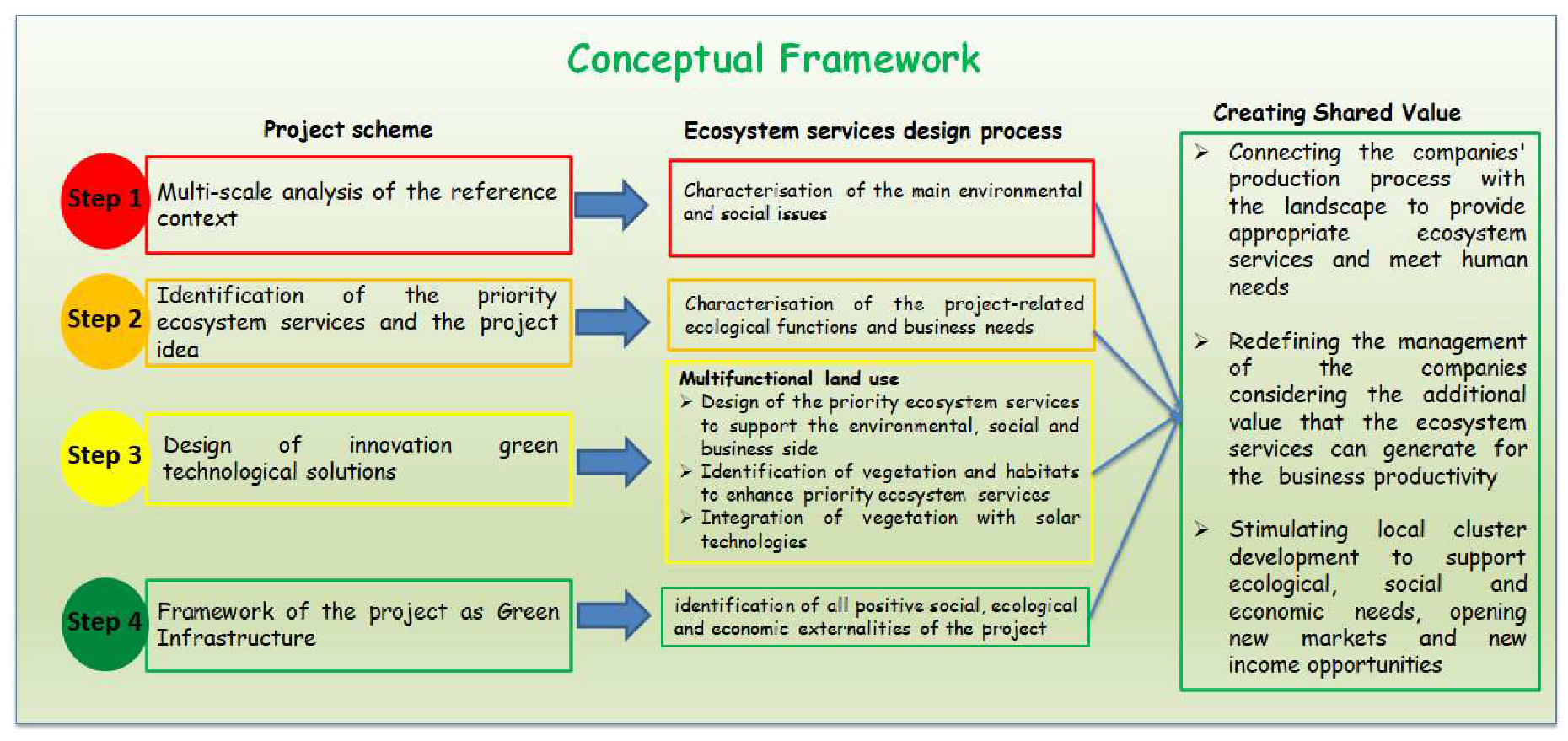
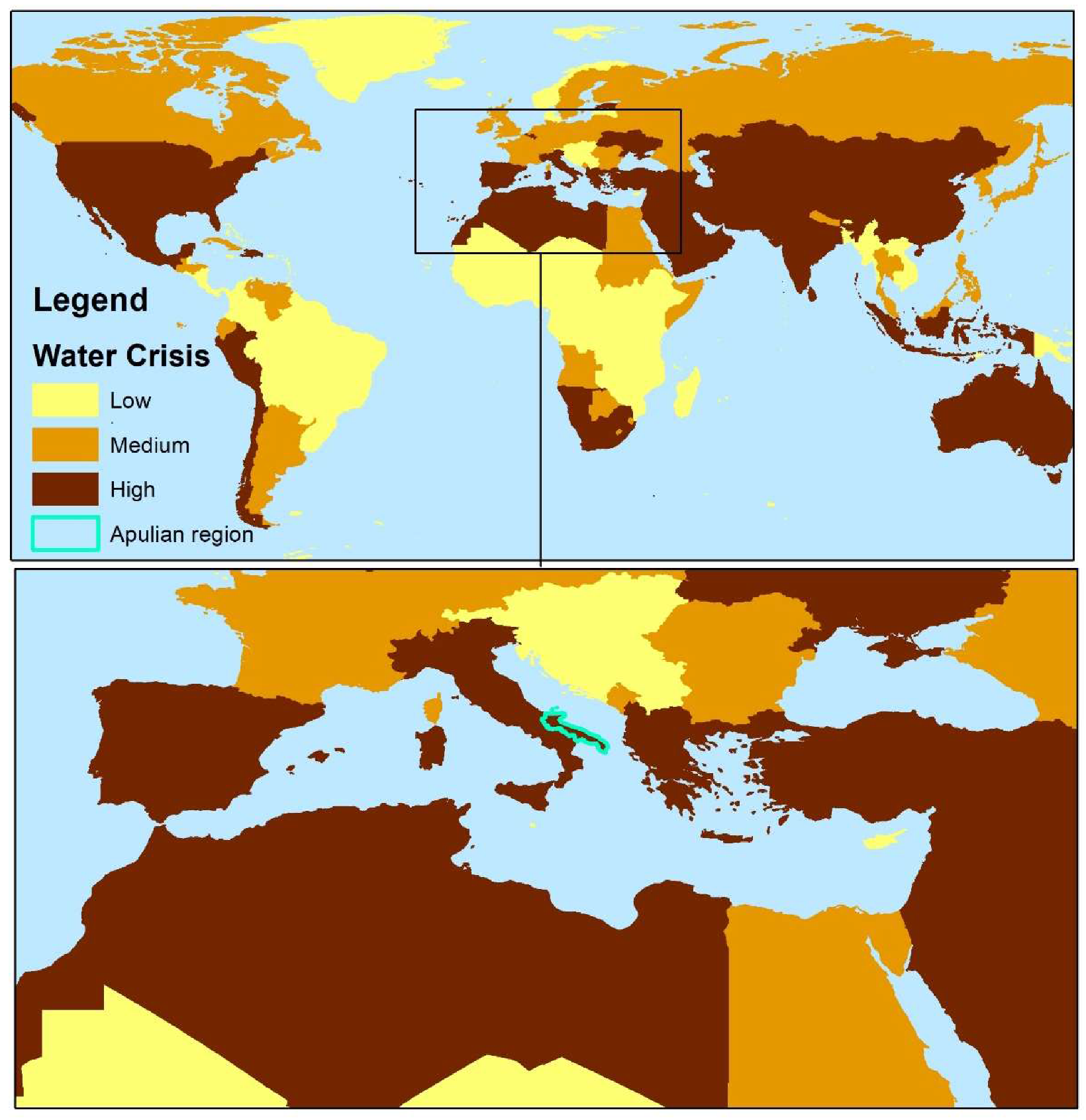
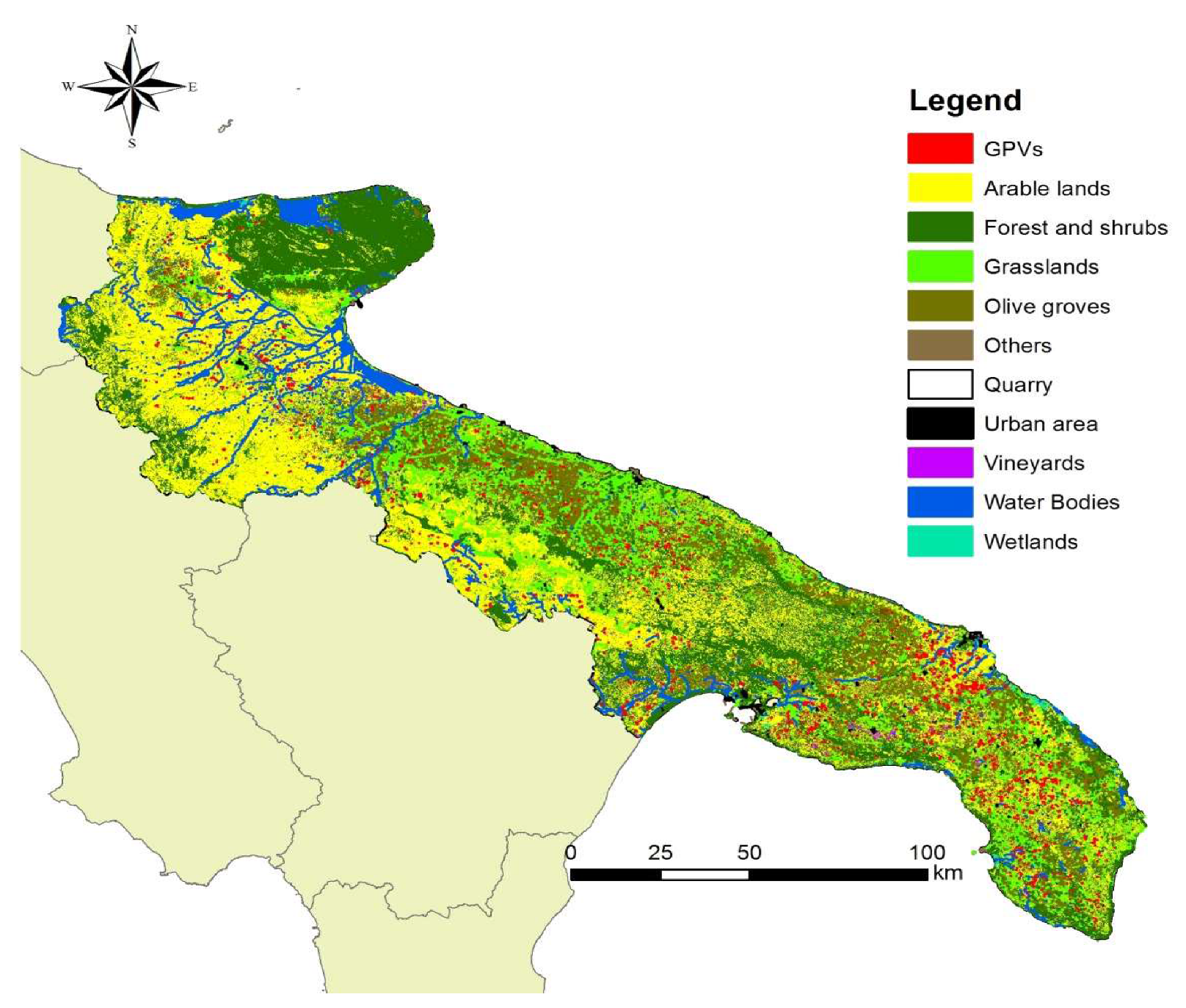
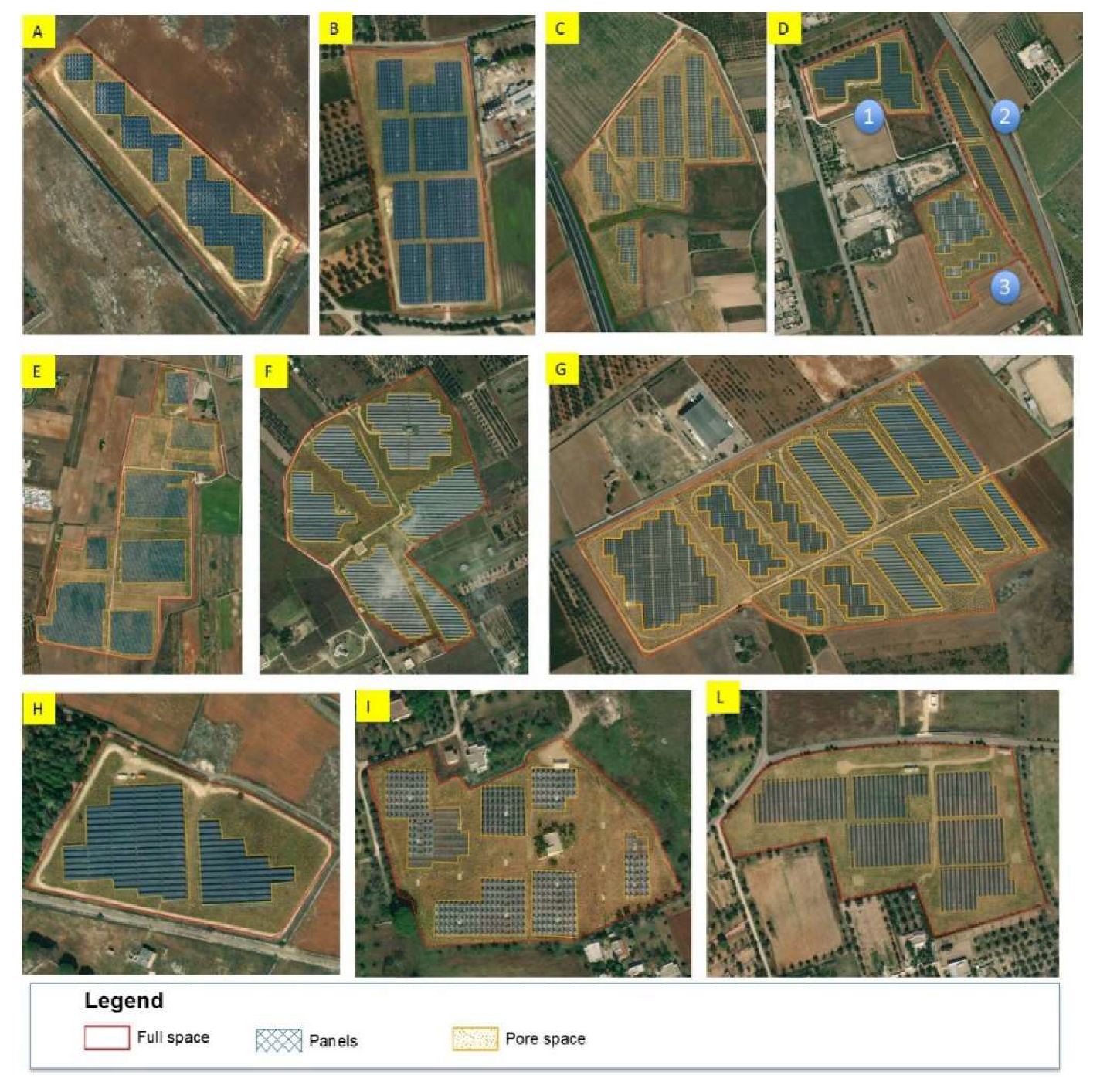

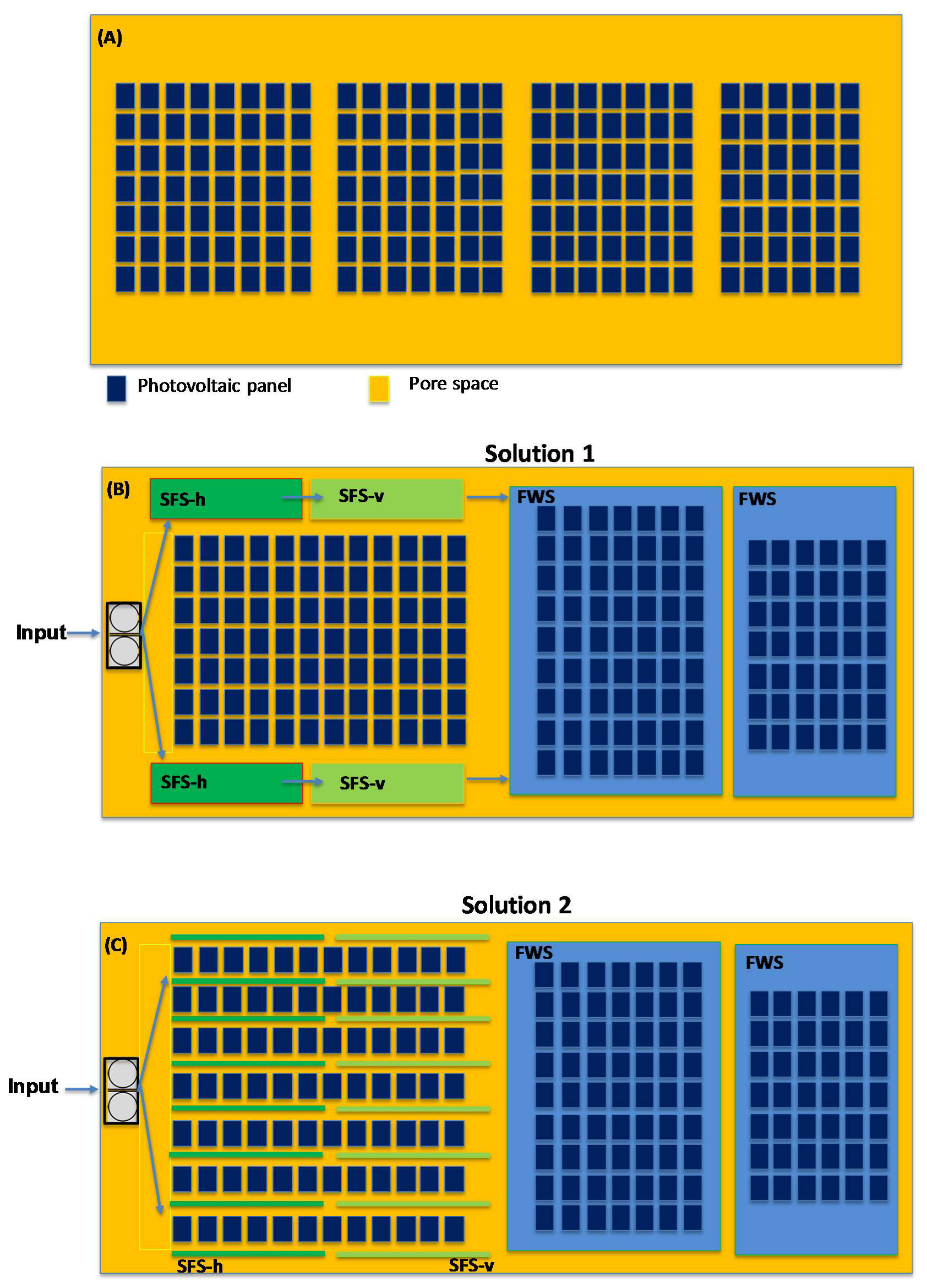
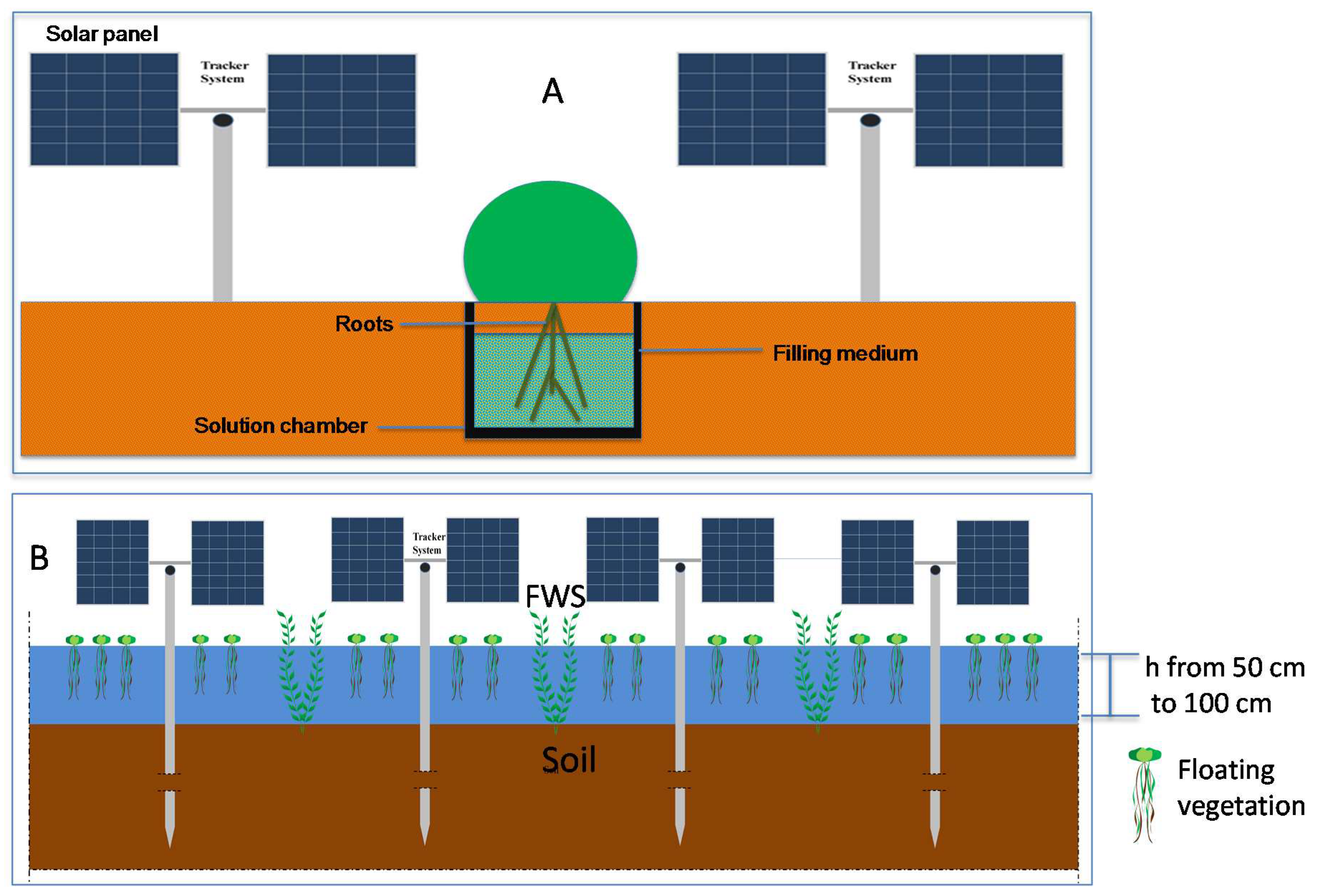
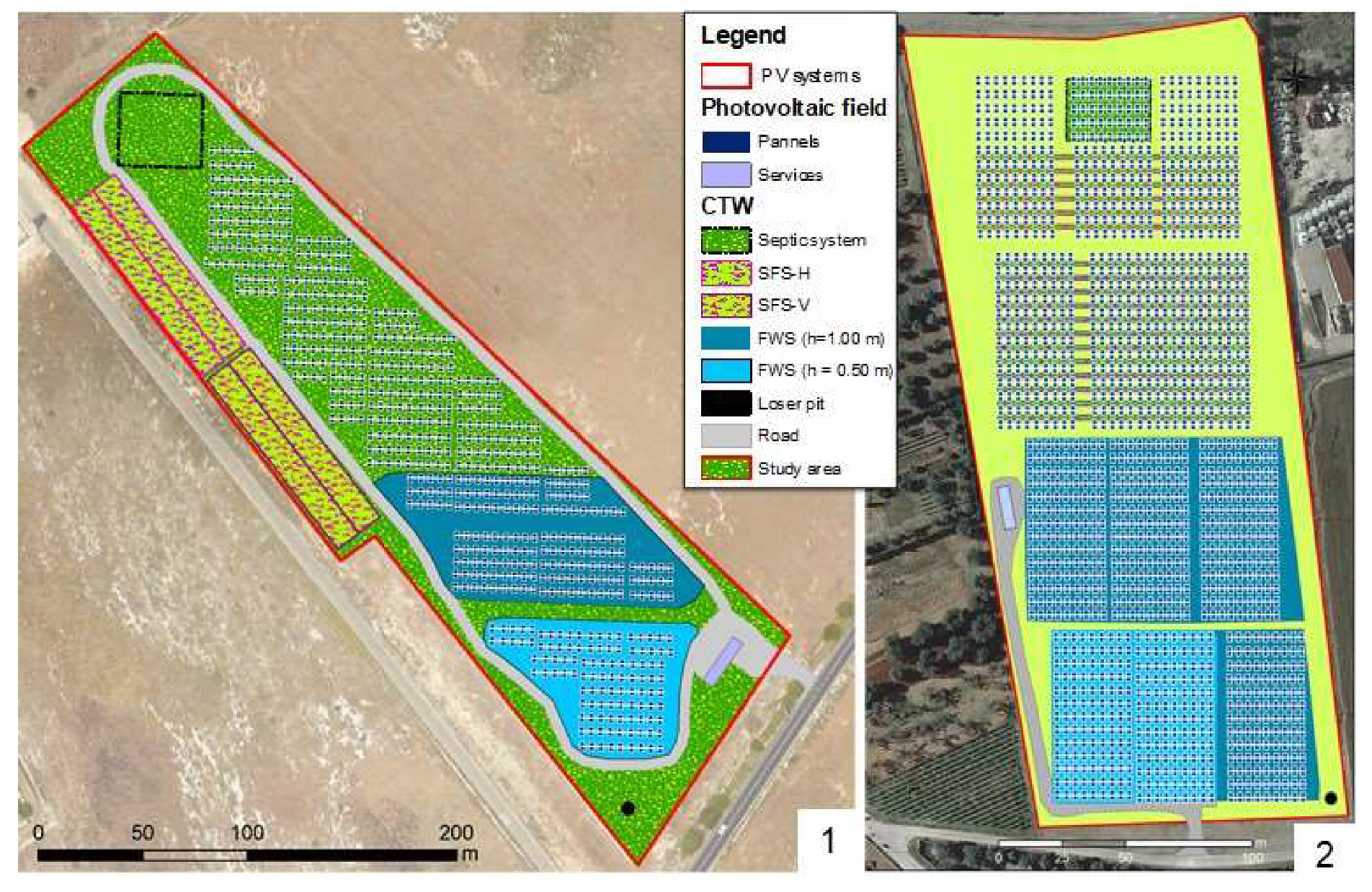
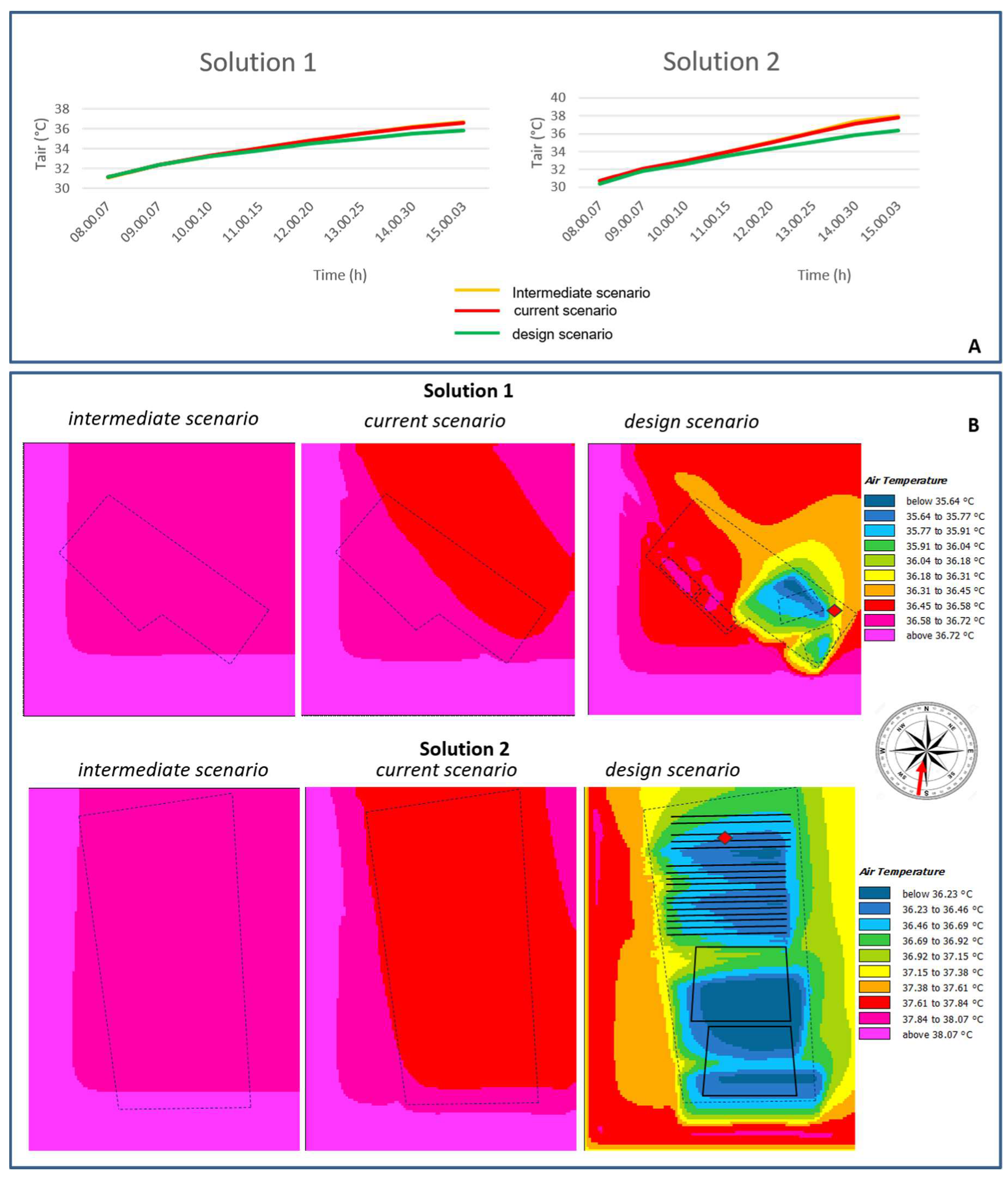

| Land-Use Classification | Land Use in the Apulia Region in 2011 | Land Use Loss for GPVs in 2016 | ||
|---|---|---|---|---|
| ha | % | ha | % | |
| Arable lands | 777,171 | 40 | 3780 | 70% |
| Forest and shrubs | 190,424 | 10 | 0 | 0 |
| Grasslands | 128,931 | 7 | 199 | 4% |
| Olive groves | 457,228 | 24 | 330 | 6% |
| Others | 63,353 | 3 | 234 | 5% |
| Quarry | 7524 | 0 | 261 | 5% |
| Urban areas | 146,371 | 8 | 0 | 0 |
| Vineyards | 137,205 | 7 | 584 | 11% |
| Water bodies | 22,571 | 1 | 0 | 0 |
| Wetlands | 2092 | 0 | 0 | 0 |
| Total | 1,932,869 | 100 | 5388 | 100% |
| GPV Systems | Pore Space (ha) | Panels (ha) | Full Space | Pore Space/Full Space | Land Use Loss |
|---|---|---|---|---|---|
| A | 1.72 | 1 | 2.72 | 63% | Arable lands |
| B | 1.8 | 2.3 | 4.1 | 44% | Arable lands |
| C | 3.6 | 2.9 | 6.5 | 55% | Arable lands |
| D1 | 1.3 | 1.4 | 2.7 | 48% | Arable land and vineyards |
| D2 | 1.9 | 1 | 2.9 | 66% | |
| D3 | 1.6 | 1.2 | 2.8 | 57% | |
| E | 30.1 | 30.2 | 60.3 | 50% | Arable land and vineyards |
| F | 3.9 | 4.4 | 8.3 | 47 | Arable land and vineyards |
| G | 11.1 | 9.7 | 20.8 | 53% | Arable lands |
| H | 1.9 | 1.1 | 3.0 | 63% | Arable land |
| I | 1.0 | 1.3 | 2.2 | 41% | Arable lands and olive groves |
| L | 1.8 | 1.6 | 3.6 | 53% | Vineyards |
| Parameter | Definition | Value |
|---|---|---|
| Simulation time | Start Date | 7 July 2018 |
| Start of simulation (h) | 07:00 | |
| Total simulation time | 8 h | |
| Meteorological conditions | Wind speed | 0.9 m/s |
| Wind direction | 210° | |
| Temperature of atmosphere (forced) | Daily profile (7 July 2018) | |
| Relative humidity (%) (forced) | Daily profile (7 July 2018) | |
| Solar radiation and clouds | Adjustment factor for solar radiation (Lecce) | 0.81 |
| Cover of low clouds (octas) | 1.00 (clear sky) | |
| Cover of medium clouds | 0.00 (clear sky) | |
| Cover of high clouds | 0.00 (clear sky) | |
| Soil | initial temperature (K) and relative humidity (%) of upper layer 0–0.2 m | 293—50 (default values) |
| initial temperature (K) and relative humidity (%) of middle layer 0.2–0.5 m | 293—60 (default values) | |
| initial temperature (K) and relative humidity (%) of deep layer below 0.5 m | 293—60 (default values) | |
| Computational domain and grid | Grid cells (x,y,z) | 150 × 150 × 20 (area A) 120 × 160 × 20 (area B) |
| δx × δy × δz | 2 × 2 × 2 m (equidistant: 5 cells close to the ground) | |
| Nesting grids | 5 | |
| Boundary conditions | Cyclic |
| Functions | Ecosystem Services | CTW | References | |
|---|---|---|---|---|
| Regulation functions (Maintenance of essential ecological processes and life support systems) | Gas regulation | Maintenance of (good) air quality Influence on climate | +++ | [10,75,78,99,100,101] |
| Climate regulation | Maintenance of a favorable climate (temp., precipitation, etc.) for human habitation, health, cultivation. | +++ | [10,75,80,82,99,100,101] | |
| up to 2 °C decrease | estimation from the simulations performed (Figure 9) | |||
| Disturbance prevention | Storm protection Flood prevention (e.g., by wetlands and forests) | +++ | [10,75,80,82,99,100,101] | |
| Water regulation | Drainage and natural irrigation | +++ | [10,75,80,82] | |
| Water supply | Provision of water for consumptive use (e.g., drinking, irrigation and industrial use) | +++ | [10,75,80,82] | |
| From 47,450 m3 to 54,750 m3 | estimation from the solutions in Figure 8 | |||
| Nutrient regulation | Maintenance of healthy soils and productive ecosystems | ++ | [10,75,80,82] | |
| Wastewater treatment | Pollution control/detoxification Filtering of dust particles (air quality) Abatement of noise pollution | +++ | [10,75,78,80,82] | |
| From 47,450 m3 to 54,750 m3 | estimation from the solutions in Figure 8 | |||
| Pollination | Pollination of wild plant species Pollination of crops. | + | [10,75,80,84] | |
| Habitat functions (Providing habitat (suitable living space) for wild plant and animal species) | Refugium function | Maintenance of biological and genetic diversity (and, thus, the basis for many other functions) | +++ | [10,75,78,84] |
| Nursery function | Maintenance of commercially harvested species | ++ | [10,75,78,84] | |
| Production functions (Provision of natural resources) | Food | Hunting, game, fruits, etc. Small-scale subsistence | + | [10,75,78,84] |
| Raw materials | Building and Manufacturing (e.g., lumber) Fuel and energy (e.g., fuel wood) | +++ | [10,75,78,84] | |
| Information functions (Providing opportunities for cognitive development) | Aesthetic information | Enjoyment of scenery (scenic roads, housing, etc.) | ++ | [10,75,78,81] |
| Science and education | Use of natural systems for school excursions, etc. Use of nature for scientific research | ++ | [10,75,78,81] | |
| Carrier functions (Providing a suitable substrate or medium for human activities and infrastructure) | Habitation | Living space (ranging from small settlements to urban areas) | + | [10,75,78,81] |
© 2020 by the authors. Licensee MDPI, Basel, Switzerland. This article is an open access article distributed under the terms and conditions of the Creative Commons Attribution (CC BY) license (http://creativecommons.org/licenses/by/4.0/).
Share and Cite
Semeraro, T.; Aretano, R.; Barca, A.; Pomes, A.; Del Giudice, C.; Gatto, E.; Lenucci, M.; Buccolieri, R.; Emmanuel, R.; Gao, Z.; et al. A Conceptual Framework to Design Green Infrastructure: Ecosystem Services as an Opportunity for Creating Shared Value in Ground Photovoltaic Systems. Land 2020, 9, 238. https://doi.org/10.3390/land9080238
Semeraro T, Aretano R, Barca A, Pomes A, Del Giudice C, Gatto E, Lenucci M, Buccolieri R, Emmanuel R, Gao Z, et al. A Conceptual Framework to Design Green Infrastructure: Ecosystem Services as an Opportunity for Creating Shared Value in Ground Photovoltaic Systems. Land. 2020; 9(8):238. https://doi.org/10.3390/land9080238
Chicago/Turabian StyleSemeraro, Teodoro, Roberta Aretano, Amilcare Barca, Alessandro Pomes, Cecilia Del Giudice, Elisa Gatto, Marcello Lenucci, Riccardo Buccolieri, Rohinton Emmanuel, Zhi Gao, and et al. 2020. "A Conceptual Framework to Design Green Infrastructure: Ecosystem Services as an Opportunity for Creating Shared Value in Ground Photovoltaic Systems" Land 9, no. 8: 238. https://doi.org/10.3390/land9080238
APA StyleSemeraro, T., Aretano, R., Barca, A., Pomes, A., Del Giudice, C., Gatto, E., Lenucci, M., Buccolieri, R., Emmanuel, R., Gao, Z., & Scognamiglio, A. (2020). A Conceptual Framework to Design Green Infrastructure: Ecosystem Services as an Opportunity for Creating Shared Value in Ground Photovoltaic Systems. Land, 9(8), 238. https://doi.org/10.3390/land9080238













